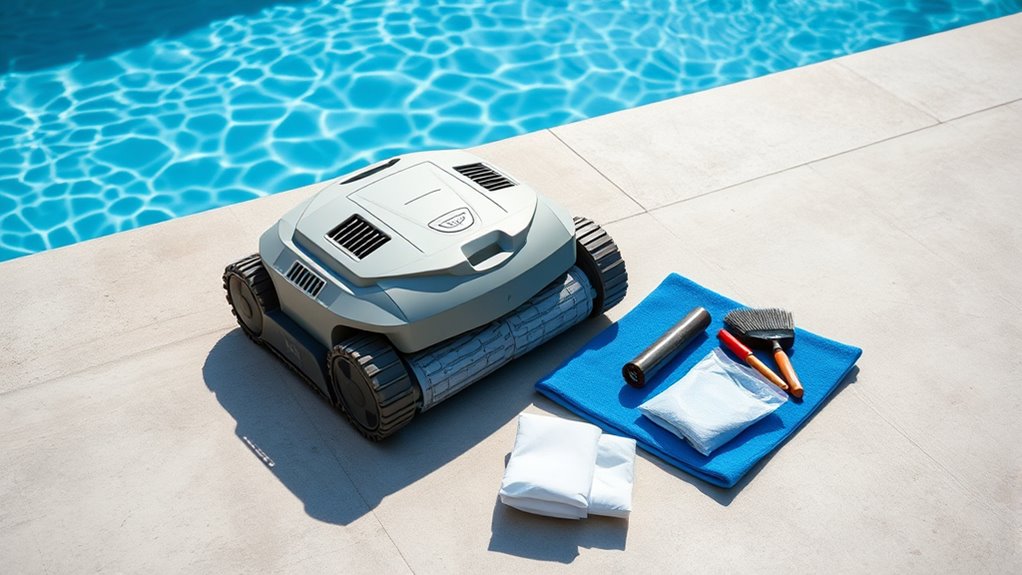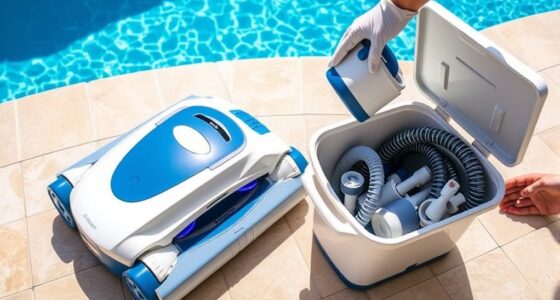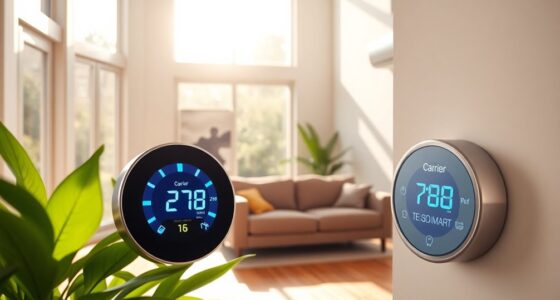To keep your automatic pool cleaner running smoothly, routinely inspect and clean brushes, tracks, filters, and internal parts. Check hoses, cables, and mechanical components for damage or wear, replacing them as needed. Regularly clear skimmer and intake valves, and store your cleaner properly during off-seasons, protecting it from freezing or moisture. Don’t forget to maintain the battery if you have a battery-operated model. Keep up with these steps to guarantee the best cleaning results, and you’ll discover more tips as you continue.
Key Takeaways
- Regularly inspect and clean brushes, wheels, and internal components to ensure optimal cleaning performance.
- Maintain filters, skimmers, and valves by cleaning or replacing to prevent clogs and improve water flow.
- Check and replace damaged cables, hoses, and mechanical parts to avoid operational failures.
- Store the cleaner properly in a dry, cool place during off-season, and protect from freezing temperatures.
- Perform routine water chemistry checks and troubleshoot using error codes for consistent, efficient cleaning.
Understanding Your Automatic Pool Cleaner

Understanding your automatic pool cleaner is essential for effective maintenance and ideal performance. There are different types of pool cleaners, including suction-side, pressure-side, and robotic models, each with unique features. Knowing which type you have helps you troubleshoot issues and optimize cleaning cycles. The advantages of automatic cleaners are clear—they save you time, reduce manual labor, and keep your pool consistently clean. They operate independently, reaching hard-to-access spots and maintaining water quality. By understanding your specific model’s functions and mechanics, you can perform routine upkeep more efficiently and prevent common problems. Additionally, familiarizing yourself with the design and mechanics of your cleaner allows for better troubleshooting and maintenance. Whether your cleaner is robotic or operates on suction or pressure, familiarizing yourself with its technology and features guarantees you get the most out of your investment and maintain a pristine pool effortlessly. Regular inspections and understanding the internal components can further enhance your maintenance routine and extend the lifespan of your cleaner. Moreover, awareness of regional factors such as climate and water conditions can influence maintenance needs and help in choosing the right cleaning schedule. Incorporating automation in business concepts can also provide insights into optimizing your cleaning routines by adopting innovative technologies.
Regular Inspection and Cleaning of Brushes and Tracks
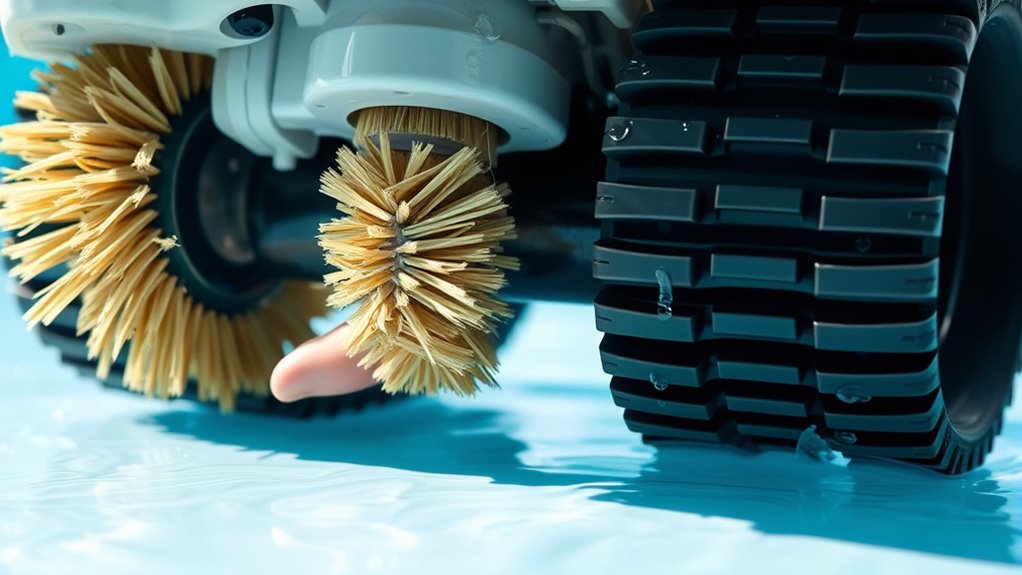
Regularly inspecting and cleaning the brushes and tracks of your automatic pool cleaner is essential to keep it functioning efficiently. Proper brush inspection ensures debris doesn’t cause unnecessary wear or blockages, while track cleaning prevents buildup that can impair movement. When checking brushes, look for signs of wear or damage, and replace if needed. For track cleaning, remove debris and dirt to maintain smooth operation. Regular maintenance helps extend your cleaner’s lifespan and improves cleaning performance. Consider these tips for peak upkeep:
Regular cleaning of brushes and tracks keeps your pool cleaner running smoothly and efficiently.
- Examine brushes for fraying or missing bristles
- Clear debris from tracks to prevent jams
- Use a soft brush or cloth to remove stubborn dirt and buildup
- Regularly inspecting HEPA filtration can help maintain optimal cleaning and skin health around your pool area. Additionally, ensuring the security of your pool equipment can prevent theft or vandalism, especially in unattended outdoor spaces. Proper maintenance also involves understanding your pool’s UV exposure to prevent potential damage to equipment and surrounding surfaces. Monitoring chemical balance can further improve the effectiveness of your cleaning routine and protect your pool surfaces.
Checking and Replacing the Filter Bag or Cartridge

To keep your automatic pool cleaner operating at its best, you need to check and replace the filter bag or cartridge regularly. Start with a filter bag inspection—remove the bag and look for tears, clogs, or accumulated debris. If it’s damaged or overly full, it’s time for a replacement. For cartridge filters, inspect the condition of the pleated elements; if they appear dirty or clogged even after rinsing, consider replacing the cartridge entirely. Regular filter maintenance ensures maximum suction and cleaning efficiency. Don’t wait until your cleaner slows down; proactive filter bag inspection and cartridge replacement keep your pool sparkling and your equipment working smoothly. Properly maintained filters extend the lifespan of your cleaner and improve overall performance. Additionally, understanding sound vibrations and their effects can contribute to more effective cleaning routines by promoting relaxation and stress reduction during maintenance. Being aware of symptoms of equipment failure can help you identify issues early and prevent costly repairs.
Clearing and Maintaining the Skimmer and Intake Valves
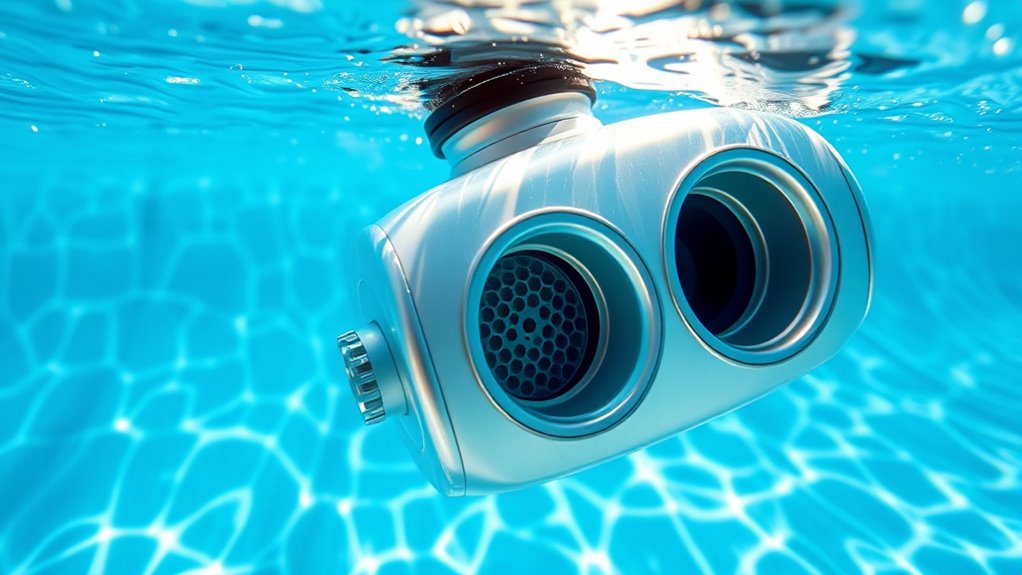
Keeping your pool cleaner’s filters in top shape is just part of the maintenance routine. Regularly clear skimmer debris to prevent clogs and guarantee smooth water flow. Check the skimmer and intake valves for any blockages caused by leaves, dirt, or other debris. Remove any obstructions promptly to avoid strain on the cleaner’s motor and maintain ideal performance. Additionally, inspecting the filtration system, including the filters and seals, helps ensure optimal water flow and prolongs the lifespan of your pool cleaner. Regular visual inspections can help identify potential issues early, saving time and repair costs. Incorporating routine maintenance checks is especially important for maintaining electric-powered pool cleaners, which rely on consistent performance for effective cleaning.
Inspecting and Replacing Worn or Damaged Cables and Hoses
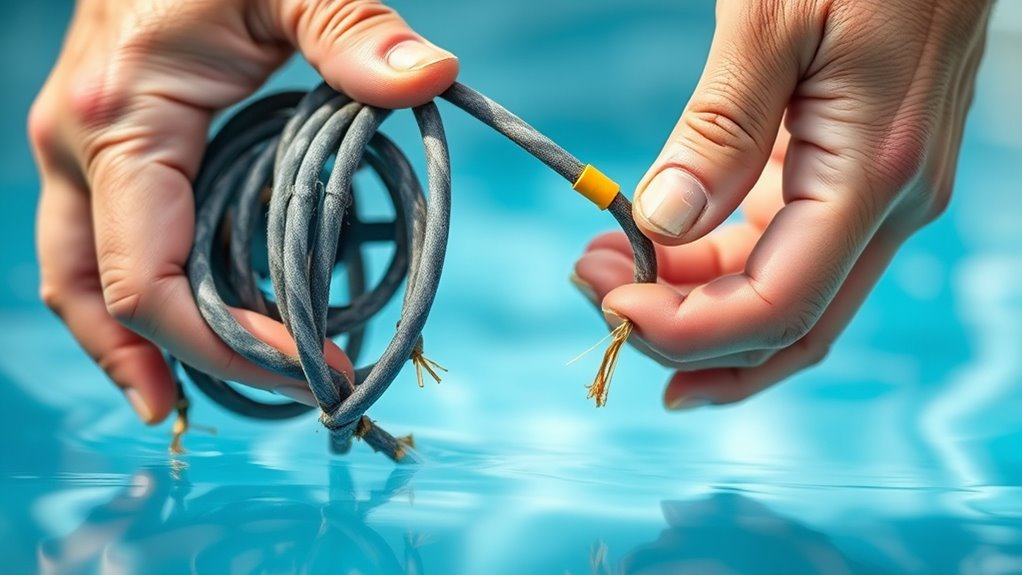
Inspecting your pool cleaner’s cables and hoses is essential for reliable operation. Begin with cable inspection, checking for frays, cuts, or corrosion that could hinder performance. Damaged cables can cause the cleaner to malfunction or stop altogether. When you spot wear or damage, replace the cables immediately to prevent further issues. Proper cable maintenance can extend the lifespan of your equipment and improve its efficiency. Additionally, maintaining the correct flushing mechanism ensures the cleaner functions effectively. Similarly, examine hoses for cracks, leaks, or stiffening, which indicate they need replacing. Damaged hoses reduce suction and cleaning efficiency. It is also advisable to stay updated on air quality and pollution that could influence the development of smarter, more reliable pool cleaning technology. Always choose the correct replacement parts compatible with your cleaner model. Regularly inspecting and replacing worn or damaged cables and hoses ensures your pool cleaner operates smoothly, prolongs its lifespan, and maintains ideal cleaning results. Staying aware of the cost of repairs associated with neglect can save you money in the long run. Stay vigilant—timely cable inspection and hose replacement are key to hassle-free pool maintenance.
Proper Storage During Off-Season

When storing your automatic pool cleaner during the off-season, make sure to keep it in a dry place to prevent rust and damage. Protect it from freezing temperatures, as ice can crack or break components. Proper storage now will help guarantee your cleaner works smoothly when you’re ready to use it again. Additionally, considering the integration of AI-driven solutions in maintenance routines can optimize performance and longevity of your equipment. Regularly inspecting and maintaining your equipment during storage can further extend its lifespan and ensure it’s ready for use when swimming season resumes. Employing proper storage practices is essential for safeguarding your investment and ensuring optimal operation in the next season. Implementing storage techniques that are tailored to your specific equipment can also prevent common issues caused by improper handling. Understanding emotional support strategies can also help handle any stress or concerns related to maintenance or equipment issues, ensuring peace of mind.
Store in a Dry Place
To guarantee your automatic pool cleaner stays in top condition during the off-season, storing it in a dry place is essential. Moisture can cause rust and damage internal components, compromising water chemistry management when you resume use. Ensure the storage area is well-ventilated and free of humidity. Before storing, clean and dry the cleaner thoroughly to prevent mold or corrosion. Consider the following for optimal storage:
- Keep away from direct sunlight to prevent material degradation
- Use a sealed container or cover to shield from dust and moisture
- Store in a cool, dry location to avoid temperature fluctuations
A proper dry environment preserves your cleaner’s longevity, ensuring it functions efficiently when you’re ready to dive back into pool season.
Protect From Freezing
Freezing temperatures can severely damage your automatic pool cleaner if not stored properly during the off-season. To protect it, ensure the pool is drained and the cleaner is thoroughly cleaned and dried. Use a pool cover to shield it from the elements and prevent moisture buildup. Proper storage involves keeping the cleaner in a temperature-controlled environment, away from freezing risks. During this time, check that the chemical balancing is maintained so residue doesn’t cause corrosion or mold. Here’s a visual to help you imagine the setup:
| Storage Conditions | Description |
|---|---|
| Pool Cover | Keeps debris and moisture out |
| Temperature Control | Prevents freezing damage |
| Dry Storage Area | Ensures the cleaner stays dry |
| Proper Cleaning | Removes chemicals and dirt |
| Regular Checks | Maintains good condition |
Battery Maintenance and Charging Tips (for Battery-Operated Cleaners)
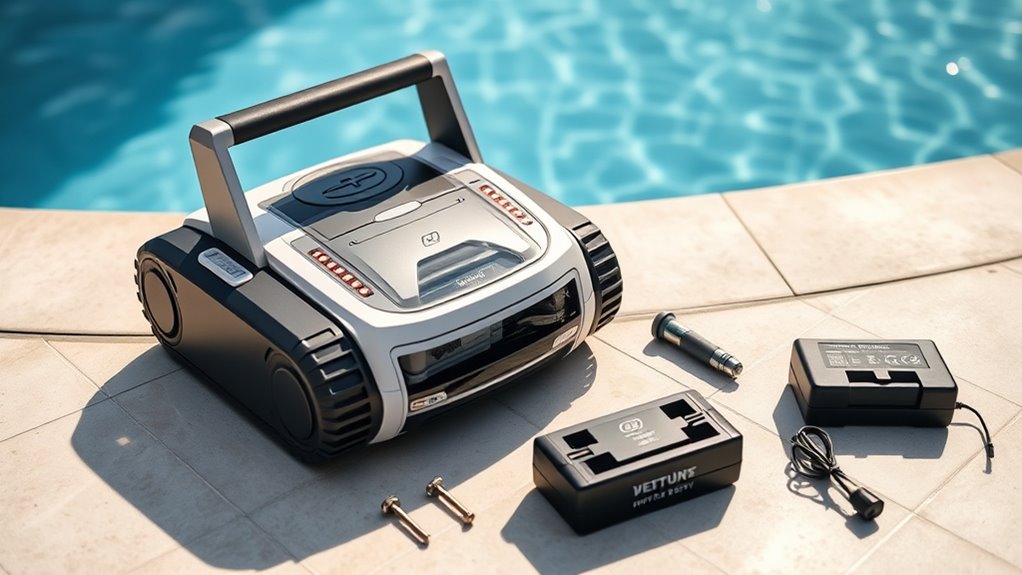
To keep your battery-operated pool cleaner running smoothly, you need to follow proper charging practices. Extending your battery’s lifespan involves smart storage and regular care. Let’s explore essential tips to maximize performance and longevity.
Proper Charging Practices
Proper charging practices are essential to keep your battery-operated pool cleaner running efficiently and extend its lifespan. To maximize performance, always use the recommended charger and avoid overcharging, which can damage the battery. Incorporate solar power when possible to supplement charging, reducing energy costs and promoting eco-friendliness. Confirm your water filtration system is clean, as debris can interfere with charging ports and reduce efficiency. Proper storage is also key: store the cleaner in a cool, dry place and disconnect it from power when not in use. Regularly check for signs of battery wear and replace batteries as needed to maintain peak operation. By following these practices, you keep your cleaner in top shape, ensuring a cleaner pool with minimal downtime.
- Use the manufacturer’s charger for best results
- Avoid charging in extreme temperatures
- Keep water filtration components clean and dry
Battery Life Extension
Maintaining your battery’s health is key to extending its lifespan and ensuring your pool cleaner performs reliably. To maximize battery lifespan, avoid excessive charging cycles by only charging when needed and unplugging once fully charged. Keep the battery at a best charge level—around 50-80%—to prevent unnecessary strain. Regularly inspecting the battery for corrosion or damage helps spot issues early. Don’t let the battery sit completely drained for long periods, as this can reduce its overall capacity. When charging, use the manufacturer-recommended charger to prevent overcharging, which shortens battery life. By managing charging cycles carefully and keeping the battery in good condition, you’ll enjoy longer-lasting power and a more dependable pool cleaning experience.
Storage and Care
When storing your battery-operated pool cleaner, it’s vital to maintain the battery in good condition to guarantee peak performance. Proper storage helps prevent capacity loss and ensures longevity. Before storing, fully charge the battery and disconnect it from the cleaner. Store the cleaner in a cool, dry place away from direct sunlight to avoid battery overheating. Regularly check the chemical balance of your pool to prevent algae buildup, which can strain the cleaner’s components. Additionally, keep the cleaner clean and dry, especially if not used for an extended period. Proper storage practices reduce the risk of corrosion and preserve the battery’s health.
- Store in a cool, dry environment away from chemicals and sunlight
- Fully charge the battery before long-term storage
- Maintain ideal pool chemical balance to prevent algae buildup
Troubleshooting Common Performance Issues

Even the best automatic pool cleaners can encounter performance issues from time to time. If your cleaner isn’t moving properly or missing spots, start by checking the automatic calibration. Sometimes, it needs a simple reset to realign its navigation. Use the troubleshooting software provided with your cleaner to run diagnostic tests; this can identify issues like sensor malfunctions or motor problems. Ensure the brushes and filters are clean, as debris can hinder performance. Verify the power supply and connections are secure. If problems persist, consult the troubleshooting software’s error codes to pinpoint specific issues. Regularly updating the software guarantees you have the latest fixes. Addressing these common problems promptly keeps your cleaner running smoothly and extends its lifespan.
Upgrading and Replacing Parts for Optimal Functionality
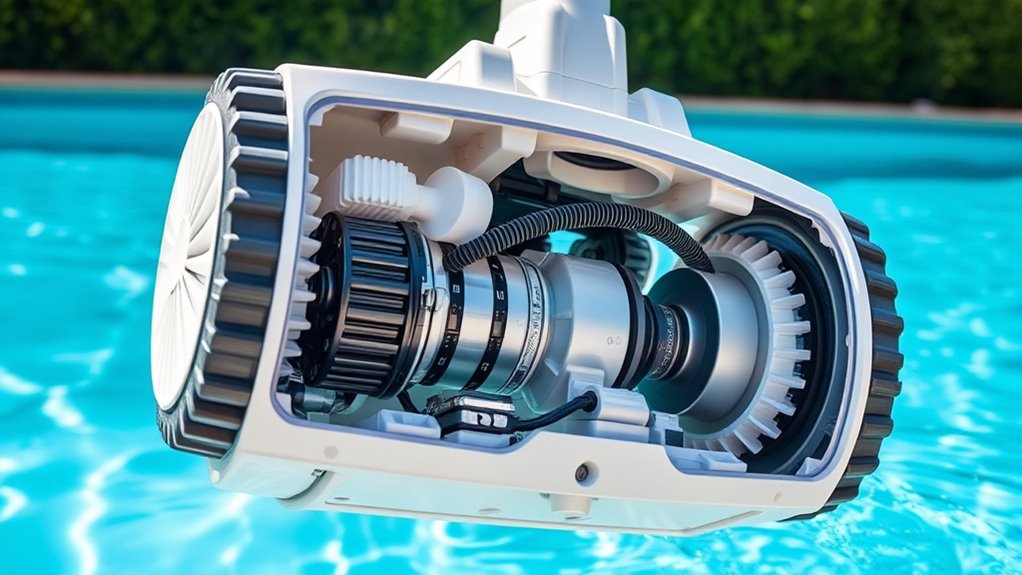
To keep your automatic pool cleaner performing at its best, upgrading and replacing parts as needed can make a significant difference. Regularly check components like brushes, filters, and hoses, replacing worn parts to maintain peak cleaning. Upgrading certain parts can also enhance efficiency, especially if your pool chemistry or chemical treatments have changed, affecting how the cleaner operates. For example, installing more durable brushes or advanced filters can improve debris removal and prolong the cleaner’s lifespan. Keeping your equipment in top shape helps prevent breakdowns and ensures consistent cleaning performance.
- Upgrade to high-efficiency brushes for better debris pickup
- Replace worn filters to optimize water flow and cleaning power
- Use corrosion-resistant hoses to withstand pool chemistry changes
Best Practices for Preventative Maintenance
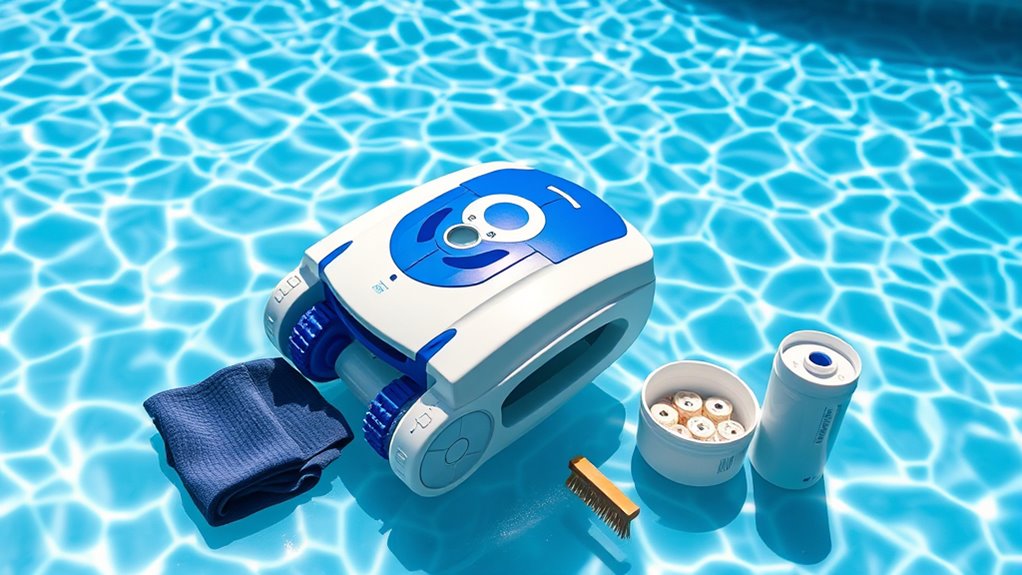
To keep your pool cleaner working efficiently, stick to a regular cleaning schedule. Make it a habit to inspect parts frequently and replace any that show signs of wear. These simple steps help prevent breakdowns and extend the life of your automatic cleaner.
Regular Cleaning Schedule
Maintaining a regular cleaning schedule is essential to keep your automatic pool cleaner functioning efficiently and prevent costly repairs. Consistent cleaning helps maintain proper pool chemistry and ensures ideal water circulation, which reduces debris buildup and mechanical strain. To stay on top of maintenance, consider the following best practices:
- Test and balance your pool’s chemistry weekly to prevent algae growth and mineral deposits.
- Clean filters and skimmers regularly to ensure free water flow and effective debris removal.
- Schedule routine inspections of the cleaner to confirm brushes and wheels are free of obstructions and functioning smoothly.
Inspect and Replace Parts
Regularly inspecting your pool cleaner’s parts is essential for catching issues before they cause breakdowns. Check the filter regularly and replace it when it’s dirty or damaged to guarantee ideal cleaning performance. A clogged or worn filter restricts water flow, reducing efficiency. Additionally, inspect the cable for signs of wear, fraying, or cuts. Damaged cables can cause the cleaner to malfunction or stop working altogether. When you notice any issues, replace worn parts promptly to prevent further damage and extend the life of your cleaner. Regular inspections and timely replacements keep your automatic pool cleaner running smoothly, saving you time and money on repairs. Staying proactive with these maintenance steps ensures your pool stays clean and your equipment lasts longer.
Frequently Asked Questions
How Often Should I Schedule Professional Servicing for My Automatic Pool Cleaner?
You should schedule professional servicing for your automatic pool cleaner at least once a year. During this service, professionals perform routine inspections to spot potential issues early and recommend replacement schedules for worn parts. Regular maintenance helps guarantee your cleaner works efficiently, prolongs its lifespan, and prevents costly repairs. By staying proactive with professional checkups, you keep your pool cleaner in top shape, saving you time and money in the long run.
Can I Use Chemical Cleaning Agents on the Cleaner’S Components?
Hold the phone—using chemical cleaning agents on your pool cleaner’s components is a bit like trusting a digital assistant with your secret recipes. You risk chemical corrosion and damage if the cleaners aren’t compatible with the parts. Always check the manufacturer’s instructions for component compatibility before applying any chemicals. Opt for gentle, designated cleaners to preserve your cleaner’s longevity and avoid costly repairs caused by chemical corrosion.
What Are Signs That My Cleaner’S Motor Is Failing?
If your cleaner’s motor is failing, you’ll notice increased motor noise and strange sounds during operation. Power fluctuations or inconsistent cleaning performance also signal motor issues. You might see the cleaner move sluggishly or stop unexpectedly. Pay attention to these signs and address them promptly. Regularly inspecting and maintaining your cleaner can help prevent motor failure, ensuring it runs smoothly and efficiently every time you use your pool.
Is It Safe to Operate My Cleaner in Cold Weather?
Did you know that operating your pool cleaner in winter can extend its lifespan? When it comes to winter operation, you should consider temperature considerations carefully. If temperatures drop below freezing, it’s safer to store your cleaner away, as cold weather can damage its components. However, in milder winter conditions, gentle use is generally safe. Always check your manufacturer’s guidelines to avoid potential damage and guarantee ideal performance during seasonal changes.
How Do I Dispose of Old or Damaged Parts Responsibly?
When disposing of old or damaged pool cleaner parts, you should prioritize eco-friendly disposal methods. Check if recycling options are available in your area for plastics and metals, and consider taking the parts to a local recycling center. Avoid throwing them in regular trash, as improper disposal can harm the environment. By recycling and choosing eco-friendly disposal options, you help reduce waste and protect the planet.
Conclusion
By tending to your automatic pool cleaner with diligent care, you’re fundamentally tuning a finely crafted instrument, ensuring its symphony of cleanliness plays on seamlessly. Regular maintenance keeps your device humming smoothly, warding off the stubborn rust of neglect. With each attentive touch, you’re not just preserving a machine—you’re safeguarding the sparkling oasis that invites relaxation and refreshment. Mastering these upkeep rituals transforms mundane chores into an artful dance of pristine waters and effortless enjoyment.
